#Wallops Flight Facility
Text

Crews preparing the Mercury Launch Escape System and Boilerplate Mercury Capsule for the LJ-1 mission, for stacking atop of the Little Joe rocket.
Date: August 20, 1959
NASA ID: link
#Little Joe 1#LJ-1#Mercury Boilerplate#Boilerplate#Little Joe#Rocket#NASA#Mercury Program#Project Mercury#Mercury#Wallops LA-1#LA-1#Wallops Flight Facility#WFF#Wallops Island#Virginia#August#1959#my post
33 notes
·
View notes
Video
undefined
tumblr
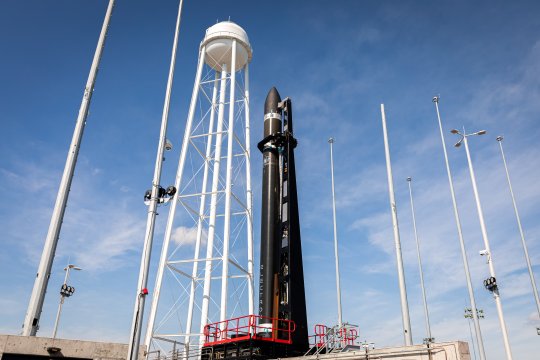


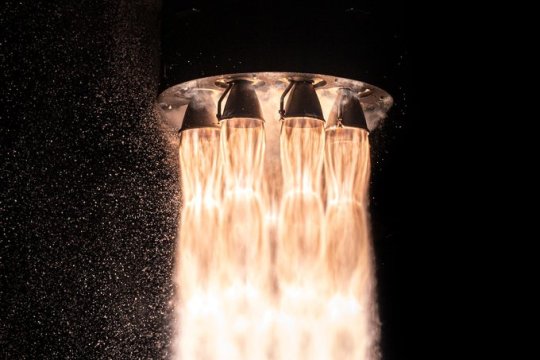

Rocket Lab Launches Electron Rocket from the US for the First Time
Rocket Lab, a prolific launch company that routinely blasts its towering Electron rockets out of New Zealand, conducted its first liftoff from US soil on Tuesday.
The mission, nicknamed “Virginia is for Launch Lovers,” took off from NASA’s Wallops Flight Facility on Virginia’s northern coast at 6 p.m. ET. The launch of the 60-foot (18.3-meter) rocket delivered three small satellites to orbit for the Earth-imaging company HawkEye 360, which uses a network of spacecraft to pinpoint radio frequencies on Earth in support of military and business projects.
Rocket Lab is among the most successful aerospace start-ups of the modern era. Unlike Elon Musk’s even more prolific rocket company, SpaceX, which builds larger rockets capable of hauling tens of thousands of pounds to orbit, Rocket Lab builds lightweight launch vehicles designed solely to lift small satellites — as compact as a loaf of bread or a refrigerator — to space.
Though the company has been headquartered in the United States since its inception, all of its prior launches have taken place at a pad near Ahuriri Point, located on the east coast of New Zealand’s North Island.
But Rocket Lab has sought for years to bring some of its launch operations stateside, in part so that it can provide services to the US government and military, which make up a lucrative slice of the global launch business customer base.
The NASA Wallops Flight Facility on Wallops Island in Virginia’s Accomack County is one of the oldest launch sites in the world. The first rocket flight took off from the site in 1945, before the creation of the space agency. More recently, the facility has been home to Northrop Grumman’s Antares rocket, which launches cargo resupply missions to the International Space Station.
By Jackie Wattles.
#Rocket Lab#Rocket Lab Launches Electron Rocket from the US for the First Time#Virginia is for Launch Lovers#Wallops Flight Facility#nasa#rocket#rocket launch#space#space mission
14 notes
·
View notes
Text
The D.C. area's no-flying-needed way to see a space launch
Tuesday night treated me to the first space launch I’d seen in person–meaning close enough to hear it–since 2018. And unlike the previous three launches that I have been privileged to experience from that close, this one did not require a flight to Florida.
Instead, only a three-hour drive lay between my house and Virginia Space’s Mid-Atlantic Regional Spaceport, hosted at NASA’s Wallops Flight…

View On WordPress
#Antares#Chincoteague#Eastern Shore#Electron#launch#launch viewing#liftoff#Mid-Atlantic Regional Spaceport#NASA Wallops#Northrop Grumman#Rocket Lab#Wallops Flight Facility#Wallops Island
0 notes
Text
NASAs Wallops Flight Facility to Launch Student Experiments
More than 50 student and faculty teams are sending experiments into space as part of NASA’s RockOn and RockSat-C student flight programs. The annual student mission, “RockOn,” is scheduled to launch from Wallops Island, Virginia, on a Terrier-Improved Orion sounding rocket Thursday, June 20, with a launch window that opens at 5:30 a.m. EDT. An […]
from NASA https://ift.tt/XUPOGWe
1 note
·
View note
Text
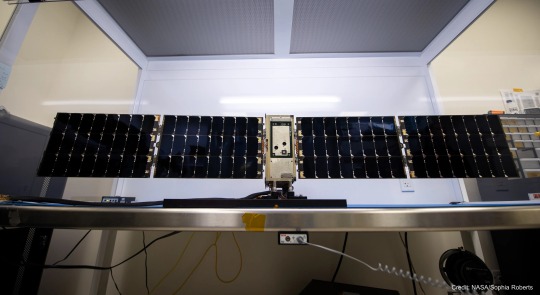
Tiny BurstCube's Tremendous Travelogue
Meet BurstCube! This shoebox-sized satellite is designed to study the most powerful explosions in the cosmos, called gamma-ray bursts. It detects gamma rays, the highest-energy form of light.
BurstCube may be small, but it had a huge journey to get to space.
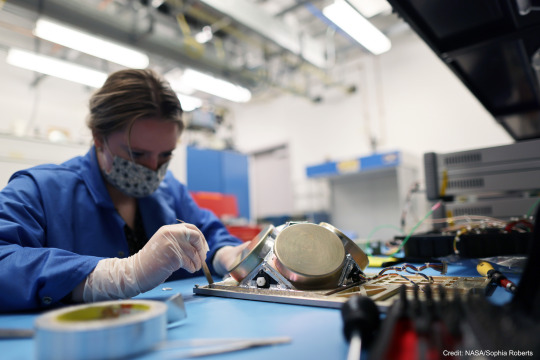
First, BurstCube was designed and built at NASA’s Goddard Space Flight Center in Greenbelt, Maryland. Here you can see Julie Cox, an early career engineer, working on BurstCube’s gamma-ray detecting instrument in the Small Satellite Lab at Goddard.
BurstCube is a type of spacecraft called a CubeSat. These tiny missions give early career engineers and scientists the chance to learn about mission development — as well as do cool science!
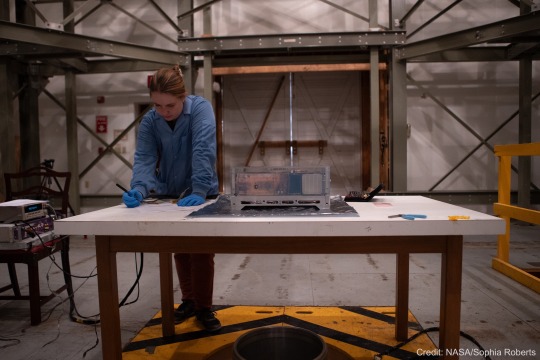
Then, after assembling the spacecraft, the BurstCube team took it on the road to conduct a bunch of tests to determine how it will operate in space. Here you can see another early career engineer, Kate Gasaway, working on BurstCube at NASA’s Wallops Flight Facility in Virginia.
She and other members of the team used a special facility there to map BurstCube’s magnetic field. This will help them know where the instrument is pointing when it’s in space.
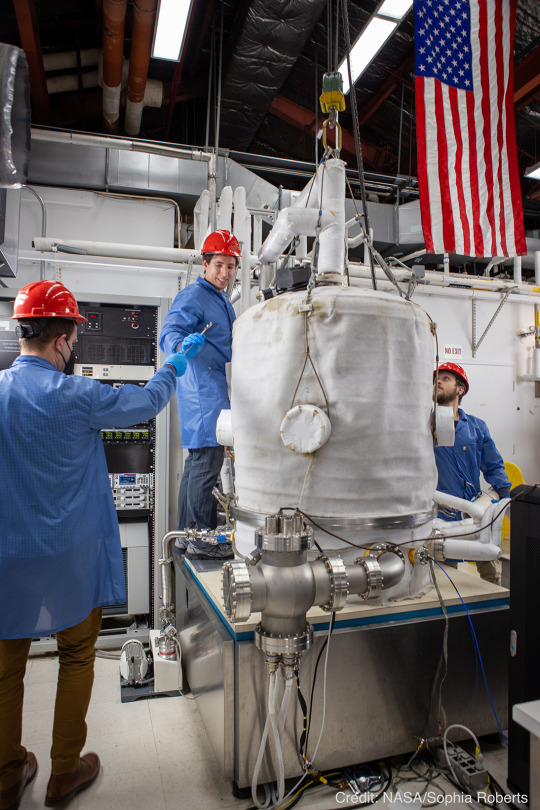
The next stop was back at Goddard, where the team put BurstCube in a vacuum chamber. You can see engineers Franklin Robinson, Elliot Schwartz, and Colton Cohill lowering the lid here. They changed the temperature inside so it was very hot and then very cold. This mimics the conditions BurstCube will experience in space as it orbits in and out of sunlight.
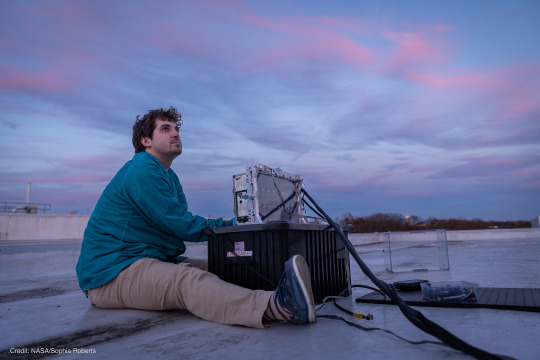
Then, up on a Goddard rooftop, the team — including early career engineer Justin Clavette — tested BurstCube’s GPS. This so-called open-sky test helps ensure the team can locate the satellite once it’s in orbit.
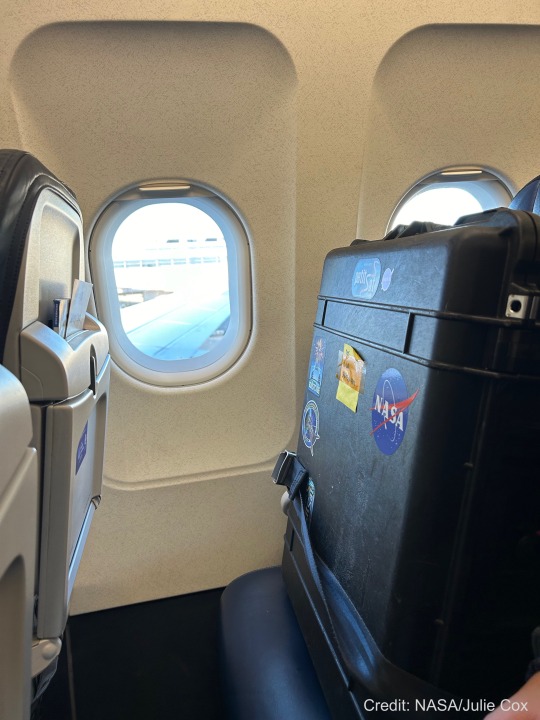
The next big step in BurstCube’s journey was a flight to Houston! The team packed it up in a special case and took it to the airport. Of course, BurstCube got the window seat!

Once in Texas, the BurstCube team joined their partners at Nanoracks (part of Voyager Space) to get their tiny spacecraft ready for launch. They loaded the satellite into a rectangular frame called a deployer, along with another small satellite called SNoOPI (Signals of Opportunity P-band Investigation). The deployer is used to push spacecraft into orbit from the International Space Station.
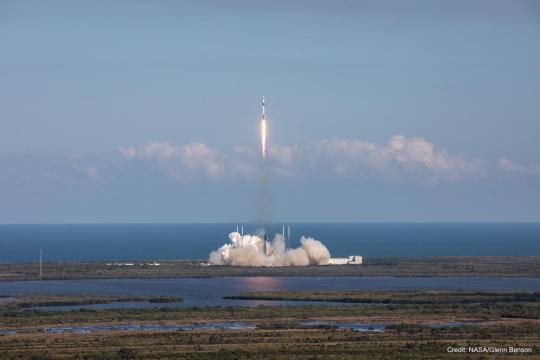
From Houston, BurstCube traveled to Cape Canaveral Space Force Station in Florida, where it launched on SpaceX’s 30th commercial resupply servicing mission on March 21, 2024. BurstCube traveled to the station along with some other small satellites, science experiments, as well as a supply of fresh fruit and coffee for the astronauts.
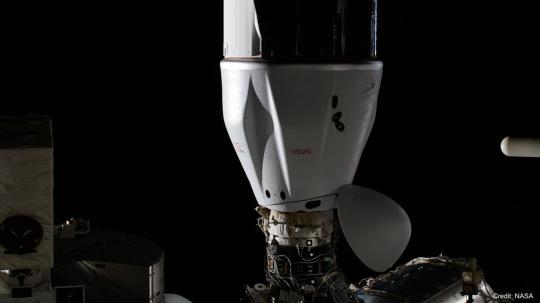
A few days later, the mission docked at the space station, and the astronauts aboard began unloading all the supplies, including BurstCube!
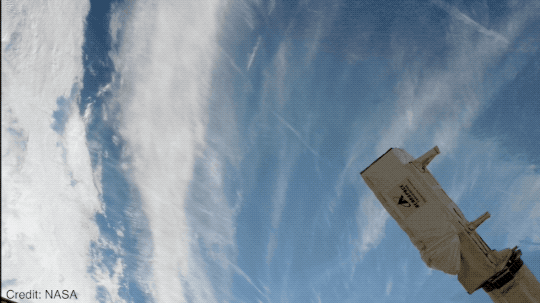
And finally, on April 18, 2024, BurstCube was released into orbit. The team will spend a month getting the satellite ready to search the skies for gamma-ray bursts. Then finally, after a long journey, this tiny satellite can embark on its big mission!
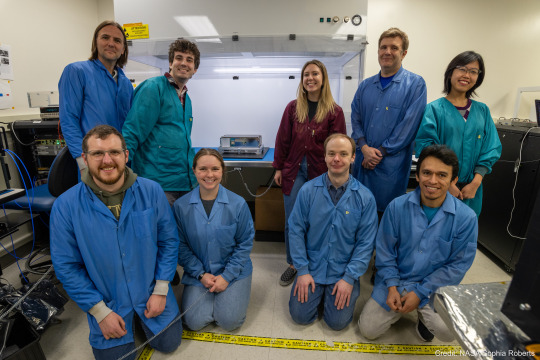
BurstCube wouldn’t be the spacecraft it is today without the input of many early career engineers and scientists. Are you interested in learning more about how you can participate in a mission like this one? There are opportunities for students in middle and high school as well as college!
Keep up on BurstCube’s journey with NASA Universe on X and Facebook. And make sure to follow us on Tumblr for your regular dose of space!
#tech#technology#dream job#jobseekers#NASA#space#spaceblr#universe#astronomy#science#gamma ray bursts#cubesat#smallsat#launch
653 notes
·
View notes
Text

Little Joe 1 on the launch pad at the Wallops Flight Facility in Virginia. August 21, 1959.
Little Joe 1 was meant to test the launch escape system for the Mercury spacecraft during a Max Q abort, when the spacecraft would be encountering the most stress during a launch. The launch escape system fired prematurely, 30 minutes before the scheduled launch of Little Joe 1. The cause was linked to an electrical fault in a coil designed to protect biological specimens from a rapid abort.
NASA
NASA SP-4201, p. 208
2 notes
·
View notes
Link
The NASA Aircraft Management Advisory Board (AMAB), which manages the agency’s aircraft fleet, has decided to relocate the agency’s P-3 aircraft at Wallops to Langley Research Center. The decision is part of a long-running, NASA-wide aircraft enterprise-management activity to consolidate the aircraft fleet where feasible and achieve greater operational efficiencies while reducing our infrastructure footprint. We all recognize this is a tough decision impacting a stellar, mission-focused team that has achieved so much over the years. I myself started my career in the Wallops Aircraft Office some 38 years ago, and my time there was foundational for all I’ve done in my career. My top priority is to work with the Aircraft Office team on a transition plan, and importantly, to carry out an effective and safe transition of the aircraft to NASA Langley, and to ensure the long term sustainability of NASA’s P-3 capability in support of the airborne science community. The Wallops aircraft office transition may take 18 to 24 months or more to accomplish. A specialized team is forming to ensure a smooth transition, and in the meantime, we continue to support airborne science from the facility. With NASA’s flying mission at Wallops relocating to Langley, we recognize that the hangars and airfield at Wallops are true regional assets with great potential. NASA will issue a request for information (RFI) to identify potential customers/interest in assuming responsibility for Wallops’ airfield operations. It’s in the best interest of NASA and the region to explore other uses and opportunities for the Wallops airfield, and this RFI will help NASA evaluate future options. There is no timeline for the RFI at this time – we will provide updates as more information becomes available. What we do know – and are fully committed to – is ensuring the airfield remains an important resource for continued use by our customers, such as the U.S. Navy’s Fleet Force Command Field Carrier Landing Practice program. We’ve supported Navy flight operations at Wallops for more than 10 years and that support continues. I want to assure everyone that Wallops’ future is bright and secure – the facility has a diverse mission set of orbital and suborbital operations and a whole host of government and commercial customers expanding operations on-site. We expect Wallops’ launch cadence to increase to upward of 50 launches per year by 2030 as the facility takes on a growing portfolio of hypersonics work as well as support to commercial spaceflight. Without a doubt, the Wallops Aircraft Team is the best in the agency. They’ve had a massively successful run of operations recently with the ARCSIX missions in Greenland to supporting student research flights on both coasts and cargo transport missions all over the world to places such as Antarctica and India. I am committed to working with every member of the team on a way forward as we transition our flight operations and seek new opportunities. We will continue to communicate with you and provide information on the transition plans as they become available. All the best, Dave David L. PierceWallops Director
2 notes
·
View notes
Text
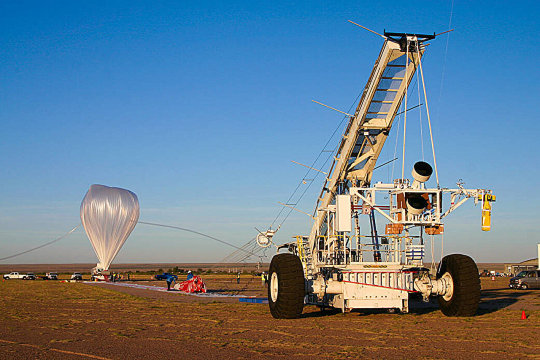
NASA to launch 8 scientific balloons from New Mexico
NASA's Scientific Balloon Program has kicked off its annual fall balloon campaign at the agency's balloon launch facility in Fort Sumner, New Mexico. Eight balloon flights carrying scientific experiments and technology demonstrations are scheduled to launch from mid-August through mid-October.
The flights will support 16 missions, including investigations in the fields of astrophysics, heliophysics, and atmospheric research.
"The annual Fort Sumner campaign is the cornerstone of the NASA Balloon Program operations," said Andrew Hamilton, acting chief of NASA's Balloon Program Office.
"Not only are we launching a large number of missions, but these flights set the foundation for follow-on missions from our long-duration launch facilities in Antarctica, New Zealand, and Sweden. The Fort Sumner campaign is also a strong focus for our student-based payloads and is an excellent training opportunity for our up-and-coming scientists and engineers."
Returning to the fall lineup is the EXCITE (Exoplanet Climate Infrared Telescope) mission led by Peter Nagler, principal investigator, NASA's Goddard Space Flight Center in Greenbelt, Maryland. EXCITE features an astronomical telescope developed to study the atmospheric properties of Jupiter-type exoplanets from near space. EXCITE's launch was delayed during the 2023 campaign due to weather conditions.
"The whole EXCITE team is looking forward to our upcoming field campaign and launch opportunity from Fort Sumner," said Nagler. "We're bringing a more capable instrument than we did last year and are excited to prove EXCITE from North America before we bring it to the Antarctic for our future long-duration science flight."
Some additional missions scheduled to launch include:
Salter Test Flight: The test flight aims to verify system design and support several smaller payloads on the flight called piggyback missions.
HASP 1.0 (High-Altitude Student Platform): This platform supports up to 12 student payloads and assists in training the next generation of aerospace scientists and engineers. It is designed to flight test compact satellites, prototypes, and other small payloads.
HASP 2.0 (High-Altitude Student Platform 2): This engineering test flight of the upgraded gondola and systems for the HASP program aims to double the carrying capability of student payloads.
DR-TES (mini-Dilution Refrigerator and a Transition Edge Sensor): This flight will test a cooling system and a gamma-ray detector in a near-space environment.
TIM Test Flight (Terahertz Intensity Mapper): This experiment will study galaxy evolution and the history of cosmic star formation.
THAI-SPICE (Testbed for High-Acuity Imaging—Stable Photometry and Image-motion Compensation Experiment): The goal of this project is to build and demonstrate a fine-pointing system for stratospheric payloads with balloon-borne telescopes.
TinMan (Thermalized Neutron Measurement Experiment): This hand-launch mission features a 60-pound payload designed to help better understand how thermal neutrons may affect aircraft electronics.
An additional eight piggyback missions will ride along on flights to support science and technology development. Three of these piggyback missions are technology demonstrations led by the balloon program team at NASA's Wallops Flight Facility in Virginia. Their common goal is to enhance the capabilities of NASA balloon missions.
CASBa (Comprehensive Avionics System for Balloons) aims to upgrade the flight control systems for NASA balloon missions. DINGO (Dynamics INstrumentation for GOndolas) and SPARROW-5 (Sensor Package for Attitude, Rotation, and Relative Observable Winds—Five) are technology maturation projects designed to provide new sensing capabilities for NASA balloon missions.
Zero-pressure balloons, used in this campaign, are in thermal equilibrium with their surroundings as they fly. They maintain a zero-pressure differential with ducts that allow gas to escape to prevent an increase in pressure from inside the balloons as they rise above Earth's surface.
This zero-pressure design makes the balloons very robust and well-suited for short, domestic flights, such as those in this campaign. The loss of lift gas during the day-to-night cycle affects the balloon's altitude after repeated day-to-night cycles; however, this can be overcome by launching from the polar regions, such as Sweden or Antarctica, where the sun does not set on the balloon in the summer.
To follow the missions in the 2024 Fort Sumner fall campaign, visit NASA's Columbia Scientific Balloon Facility website for real-time updates of balloons' altitudes and locations during flight.
3 notes
·
View notes
Text

Launch of a Northrop Grumman Antares Rocket
with a Cygnus Resupply Spacecraft Onboard
Pad-0A, NASA's Wallops Flight Facility, Wallops Island, Virginia
image credit: Aubrey Gemignani/NASA
13 notes
·
View notes
Text
By: Passant Rabie
Published: April 11, 2023
When Dr. Makenzie Lystrup was sworn in as the new director of NASA’s Goddard Space Flight Center last week, she didn’t take her oath of office on the Bible or the U.S. Constitution, but rather on a tome revered by space enthusiasts everywhere: Carl Sagan’s Pale Blue Dot.
The book, published in 1994, is named after an iconic image of Earth, snapped by the Voyager I probe, that depicts the planet as a small speck smothered by the emptiness of space. That photo inspired astronomer Carl Sagan to write: “Look again at that dot. That’s here. That’s home. That’s us.” For many, the book serves as a reminder of humanity’s place in the universe and the need to preserve our home planet, which makes it similar to holy scripture for a newly appointed NASA director.
On Thursday, when Lystrup chose to place her left hand on a copy of Sagan’s book while being sworn in by NASA Administrator Bill Nelson, a photographer captured the moment, and NASA Goddard’s social media shared the image.
The constitution does not require that government officials be sworn in using a particular text, just that they “shall be bound by Oath or Affirmation, to support this Constitution.” Most U.S. politicians and officials end up using the Bible.
But over the years, many officeholders have improvised while taking their oath. In 2018, Mariah Parker was sworn in as a member of the Athens-Clarke County commissioners with her hand placed on a copy of “The Autobiography of Malcom X.” When former U.S. ambassador to Switzerland Suzi LeVine took her oath in 2014, she put a hand on her Kindle. Keith Ellison, the first Muslim to be elected to Congress, took his oath in 2007 using the Quran.
Sagan is a revered figure in the space sciences community for his pioneering contributions to space exploration. “Like many astronomers and space scientists, my passion started with watching Carl Sagan’s ‘Cosmos’ on public television as a child,” Lystrup, who is a planetary scientist like Sagan, said in an emailed statement. “Sagan worked very hard to make science accessible and meaningful to everyone, and ‘Pale Blue Dot’ emphasizes the importance of exploring our universe and understanding our home planet.”
“Given its personal significance to me and how its message resonates with the work we do at NASA Goddard on behalf of the world, it felt apropos to include it in the ceremony,” she added.
Lystrup will be the first female center director of the Goddard Space Flight Center, which includes a primary campus in Greenbelt, Maryland, as well as Wallops Flight Facility in Virginia, the Katherine Johnson Independent Verification & Validation Facility in West Virginia, the Goddard Institute for Space Studies in New York, the White Sands Complex in New Mexico, and the Columbia Scientific Balloon Facility in Texas.
Goddard is home to the nation’s largest concentration of scientists, engineers and technologists dedicated to Earth and space science, according to NASA.

#Makenzie Lystrup#Carl Sagan#Pale Blue Dot#science#NASA#Goddard Space Flight Center#oath#affirmation#bible#space science#decline of religion#representation fallacy#representation matters#religion is a mental illness
14 notes
·
View notes
Text
1 note
·
View note
Text
NASA Salisbury U. Enact Agreement for Workforce Development
NASA and Salisbury University (SU) in Maryland signed a collaborative Space Act Agreement Thursday, March 28, 2024, opening new opportunities at the agency’s Wallops Flight Facility in Virginia for students in science, technology, engineering, and mathematics (STEM) fields. The agreement forges a formal partnership to identify research and engineering projects and activities at Wallops designed […]
from NASA https://ift.tt/D3Z7IGB
3 notes
·
View notes
Text
Comin’ in Hot: Seven Things to Know About our New Heat Shield
What goes up, must come down, and from space, without burning up in an atmosphere. That’s why we’re pumped for the Low-Earth Orbit Flight Test of an Inflatable Decelerator, or LOFTID. Launching on Nov. 1, 2022, with the National Oceanic and Atmospheric Administration’s (NOAA) Joint Polar Orbiting Satellite System-2 (JPSS-2) mission, this technology demonstration marks the next step in advancing an innovative heat shield design that could one day be used to land heavy payloads – including humans – on Mars!
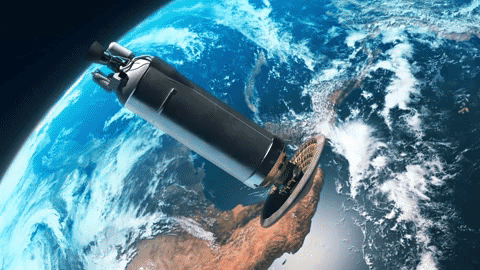
Here are seven things to know about this innovative re-entry system:
1. LOFTID is the first-ever in-orbit test of this technology.
Inflatable heat shields, called Hypersonic Inflatable Aerodynamic Decelerators (HIADs), have been in the works for more than a decade. In 2012, the third of the Inflatable Re-entry Vehicle Experiments (IRVE) launched on a suborbital sounding rocket from the Wallops Flight Facility, demonstrating a 3-meter (10-foot) diameter inflatable heat shield.
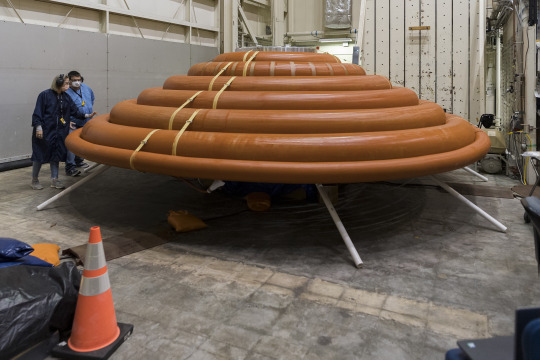
But the LOFTID re-entry vehicle, at 19.7 feet (6 meters) in diameter, will be the largest blunt body aeroshell to ever go through atmospheric entry. Designed to withstand temperatures as high as 2900°F (1600°C), this first-ever in-orbit test of this technology will prove if it can successfully slow down large payloads – such as crewed spacecraft, robotic explorers, and rocket components – enabling them to survive the heat of re-entry at planetary destinations with an atmosphere.
youtube
2. You can find out how this tech works in real-time.
LOFTID is unique in that all operations will happen within a few hours of launch. After the JPSS-2 satellite safely reaches orbit, the LOFTID vehicle will separate from the upper stage of the Atlas V rocket and begin re-entry into Earth’s atmosphere. If all goes as planned, the technology will help the vehicle decelerate from hypersonic (more than 25 times faster than the speed of sound) down to subsonic flight, less than 609 miles per hour for a safe splash down and recovery from the Pacific Ocean.
While in flight, engineers at NASA’s Langley Research Center will receive location data every 20 seconds and onboard sensors and cameras will record more comprehensive data about the technology’s performance. You can get a behind-the-scenes look at Langley’s Flight Mission Support Center where the LOFTID project team will be monitoring the flight test at NASA.gov/live following the launch.
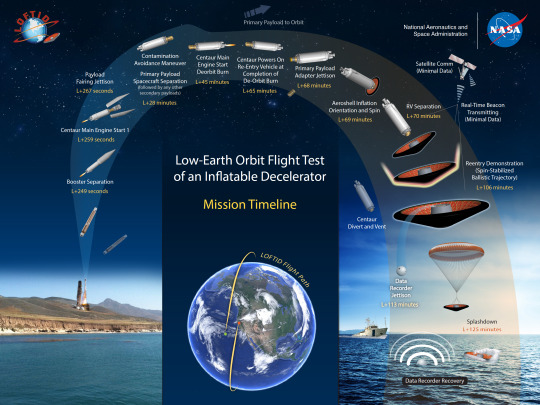
3. A lemon-sized capsule ejected into the Pacific Ocean will hold key flight data.
The LOFTID re-entry vehicle will record both sensor and camera data during its flight. The data will include the temperatures and pressures experienced by the heat shield and will illustrate how well the technology performed during the demonstration.
Although the goal is to retrieve the LOFTID re-entry vehicle after it splashes down in the Pacific Ocean, the team wanted a back-up option just in case they can’t recover it. Enter the tiny yellow package called an ejectable data module (EDM) which will also record flight data. The EDM will be released from the spacecraft at an altitude of about 50,000 feet. It will free fall into the Pacific Ocean off the coast of Hawaii and should land within 10 miles of the spacecraft’s splash down location. A recovery team, that has practiced hide-and-seek of the EDM on land and sea, will use GPS to search an approximately 900-mile area of the Pacific Ocean to find their “lemon.”
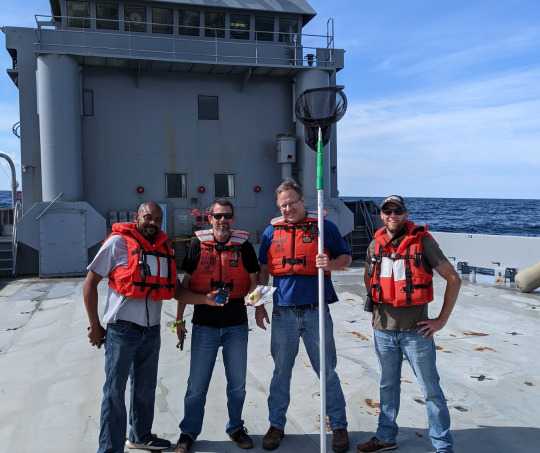
4. This heat shield packs a punch.
Although NASA has historically relied on rigid aeroshells, parachutes, and retro-propulsion (rockets) to decelerate people, vehicles, and hardware during entry, descent, and landing operations, a benefit of inflatable heat shields is that they take up less space in a rocket, allowing more room for other hardware or payloads. LOFTID’s aeroshell has been folded and tightly packed down to 4 by 1.5 feet for launch and stacked in the United Launch Alliance (ULA) Atlas V rocket payload fairing.

5. LOFTID is dedicated in honor of one of its innovators.
LOFTID was developed as a partnership with ULA and is dedicated to the memory of Bernard Kutter, ULA manager of advanced programs, who passed away in August 2020. Kutter was instrumental in advancing the inflatable heat shield design and developing the plan to test the system on an Atlas V rocket. He was an advocate for both space technology and expanding access to space. Kutter’s NASA and ULA counterparts agree that LOFTID is unlikely to have made it to space without his vision and passion.
youtube
6. LOFTID is made of tough stuff.
Synthetic fibers make up the inflatable structure, braided into tubes that are, by weight, 10 times stronger than steel. The tubes are coiled so that they form the shape of a blunt cone when inflated. The thermal protection system that covers the inflatable structure can survive searing entry temperatures up to 2,900 degrees Fahrenheit. Researchers used the same heat-shielding materials to create a fire shelter prototype for firefighters battling forest fires.
youtube
7. You can make your own LOFTID Halloween costume!
Still looking for an out-of-this world Halloween costume? With a few commonly found materials, like orange pool noodles and duct tape, you can create your own LOFTID costume. However, we make no promises of protecting or slowing you down from becoming the life of the party.

Follow @NASA_Technology for the latest updates on LOFTID. Don’t miss our live coverage leading up to launch from the Vandenberg Space Force Base in California. The NASA Edge JPSS-2 Tower Rollback Show airs live on NASA TV and YouTube on Tuesday, Nov. 1 at 12 a.m. EDT, and NASA TV live launch coverage will begin at 4:45 a.m. EDT.
Make sure to follow us on Tumblr for your regular dose of space!
1K notes
·
View notes
Text
NASA Wallops to Support Sounding Rocket Launch for U.S. Navy Fleet Training
A rocket-propelled target is scheduled for launch July 27-28, 2024 from NASA’s launch range at the Wallops Flight Facility in Virginia in support of a U.S. Navy Fleet Training exercise. No real-time launch status updates will be available. The launch will not be livestreamed nor will launch status updates be provided during the countdown. The […]
Continue reading NASA Wallops to Support Sounding…
0 notes
Text

My son Joseph is over the moon since, through SSAI, he will serve as Media Intern at the Virginia Space Flight Academy’s Space Adventure Camp at NASA's Wallops Flight Facility, Wallops Island, VA starting Saturday, July 6, 2024. The Space Adventure Camp is a residential camp experience on aerospace, coding and robotics for kids 11-16 years of age. Congratulations, Joseph! Thank you, SSAI!
0 notes
Link
2 min readPreparations for Next Moonwalk Simulations Underway (and Underwater) A wireframe image of an aircraft being designed.NASA The Hypersonic Technology project is divided into four research topic areas. The first research topic is system-level design, analysis, and validation, which explores the impacts of technologies on vehicle performance. The second and third topics focus more specifically on propulsion technologies and vehicle technologies enabling hypersonic flight. The fourth topic area explores material technology that can survive and be reused in high-temperature hypersonic flight. System-Level Design and Analysis The System-Level Design, Analysis, and Validation research topic (RT-1) investments are focused on computational tool development and validation for hypersonic propulsion and vehicle system analysis methods including uncertainty quantification. RT-1 coordinates and performs definitive systems analysis studies to clarify the potential benefits of hypersonic vehicles and technologies for both high-speed civilian travel and space access and will use these studies to drive a technology portfolio focused on reusability, affordability, and reliability. An illustration of a hypersonic vehicle.NASA Propulsion Technologies The Propulsion Technologies research topic (RT-2) focuses on turboramjet, ramjet, integrated combined-cycle, dual-mode, and scramjet propulsion systems and associated propulsive mode transitions, combustor operability, fuels, controls, and sensors. RT-2 develops computational fluid dynamic technologies to enable predictive simulations of these systems. Hypersonic model test in the 8-Foot High Temperature Tunnel at NASA Langley.NASA Vehicle Technologies The Vehicle Technologies research topic (RT-3) investments focus on understanding aerodynamic and aerothermodynamic phenomena, such as high-speed boundary-layer transition and shock-dominated flows, to further technologies that improve aerodynamic performance as well as reduce aerodynamic heating. A model of a hypersonic vehicle and sensor in NASA’s 20-Inch Mach 6 Air Tunnel in the Langley Aerothermodynamic Lab.NASA High Temperature Materials The High Temperature Durable Materials research topic (RT-4) investments focus on advanced propulsion and vehicle materials research. Due to the operating conditions of hypersonic vehicles, most of the structures and materials are shared between propulsion and vehicle components, which include aeroshell, control surface, leading edge, propulsion, and sealing concepts. RT-4 examines the design and evaluation of potential structure and material concepts through component development and testing under relevant environments. In addition, because of the extreme environments the materials and structures must endure, RT-4 also includes development of advanced thermal and structural measurement methods. Read More About Hypersonic Technology About the AuthorShannon EichornShannon Eichorn is the Strategic Engagement Lead for NASA’s Advanced Air Vehicles Program. She is a former test engineer in supersonic wind tunnels and former engineer managing facilities, such as the Aeroacoustic Propulsion Lab, Glenn Extreme Environments Rig, and Creek Road Cryogenics Complex. Facebook logo @NASA@NASAaero@NASA_es @NASA@NASAaero@NASA_es Instagram logo @NASA@NASAaero@NASA_es Linkedin logo @NASA Explore More 3 min read NASA Launches Rocket to Study Hypersonic Aircraft Article 2 years ago 1 min read AETC Hypersonic Facilities Article 8 years ago 2 min read Rocket Launch Scheduled March 21 from NASA’s Wallops Flight Facility Article 2 years ago Keep Exploring Discover Related Topics Technology Transfer & Spinoffs Small Business Innovation Research (SBIR) / Small Business Technology Transfer (STTR) Manufacturing and Materials Why Go to Space Share Details Last Updated Jun 21, 2024 EditorJim BankeContactShannon [email protected] Related TermsHypersonic TechnologyAdvanced Air Vehicles Program
0 notes